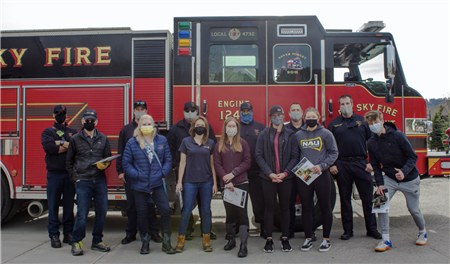
BIG SKY – On the sunny Saturday morning of May 1, a group of volunteers gathered outside the Big Sky Fire Department Station #1 to join members of the department in canvassing the community. The occasion was National Wildfire Community Preparedness Day put on by the National Fire Protection Association, and the goal was to educate the community about wildfire preparedness.
Volunteers were comprised of the Rotary Club of Big Sky and three Lone Peak High School students from the Interact Club there to support Deputy Fire Chief Dustin Tetrault and his coworkers in their efforts. In the shadow of Station #1’s fire engine, the crew circled up while Tetrault gave a run-down of the plan for the day.
“If we can educate five to ten people, I call that a success,” said Tetrault.
This is the first year that the fire department went door-to-door according to Tetrault. In the past, BSFD held in-person events such as a brewery day where community members could gather and learn while sipping local brews. Due to concerns over COVID-19, Tetrault and his crew took to the streets to make sure the Big Sky community is educated and prepared.
Participants broke into three groups to divide and conquer the various neighborhoods including Hidden Village, Skywood and Ousel Falls. Armed with educational materials and official BSFD vehicles, the groups set off to their assigned areas.
At each stop, volunteers began by asking homeowners if they were enrolled in the Gallatin County Community Notification System which is an important tool to inform the community of warnings and evacuation orders.
The packet also included information on emergency evacuation routes out of Big Sky which are U.S. Highway 191 north, U.S. Highway 191 south, and Jack Creek Road.
Homeowners were asked to think of the defensible spaces around their homes which is the space between a structure and the surrounding wildland area. If desired, BSFD crew would walk around a homeowner’s structure with them to complete a home risk assessment.
A recent $18,383 grant from the International Association of Fire Chiefs as part of their Ready Set Go! Community Chipping Program will enable BSFD to continue holding community chipping days. To participate, homeowners are asked to stack any debris in a neat pile in an accessible spot on their property. Then, BSFD can haul a chipper up to each property and dispose of the debris for free.
Educating the community, home risk assessments and chipping days are important now more than ever, according to Tetrault.
“You can really see with how we are building out our community that we’re putting more and more houses in these in these extreme risk areas,” he said. “It’s becoming more and more important that we educate the public that we’re creating a higher hazard as we build out. The three big things for us are defensible space…knowing the evacuation processes within the community and knowing the evacuation routes, and a sense of personal responsibility.”
According to a wildfire risk report by Headwaters Economics, “populated areas in Big Sky have, on average, greater risk [of wildfire] than 87 percent of communities in the state.” Not only does Big Sky have a greater risk for wildfire, we also saw an over 100 percent increase in population from 1,528 in 2010 to 3,058 in 2019 according to the report.
Tetrault also emphasized the longer burn season that is affecting the Big Sky area and droughts that are affecting the entire state. He said that the same trends that have emerged in the past few years are continuing and now we are seeing what he called “flash droughts” where areas can go 30 to 45 days with no rain, high temperatures and low humidity which dry out fields very quickly.
Big Sky experienced one of its largest wildfires to date in November of 2020 according to Tetrault. He said the fire burned almost 700 acres and emphasized the fact that it happened in November was unusual.
The community canvassing is only the beginning according to Tetrault and he hopes to follow up with more home risk assessments. He explained there is a good chance most of the fire department will be busy with fire suppression or organizing an evacuation in an emergency and that, “a lot of [responsibility] is going to fall back on the community member to take the responsibility to plan for and to be prepared for some sort of a wildfire event.”
